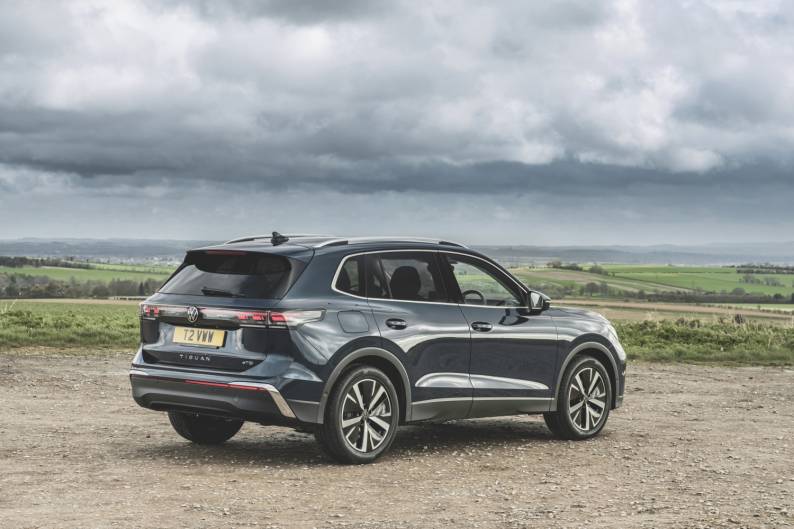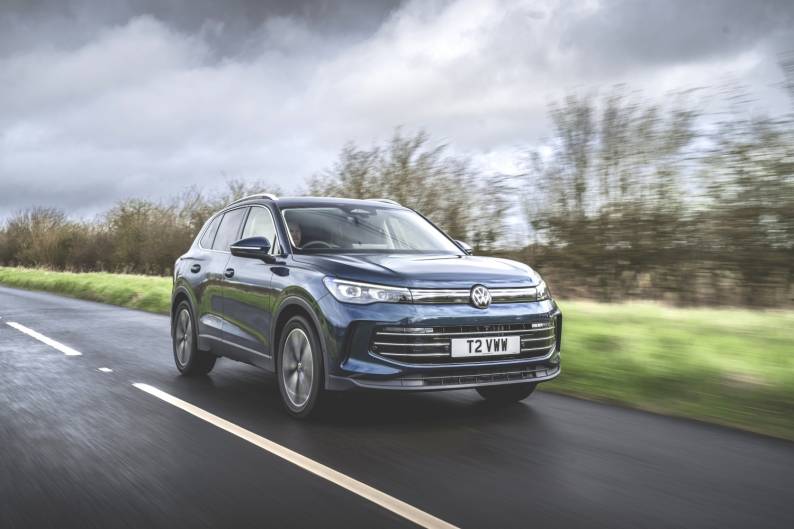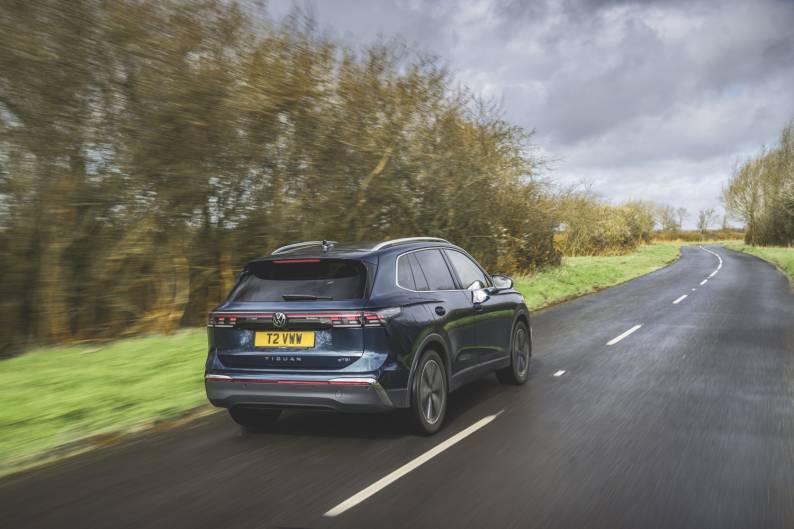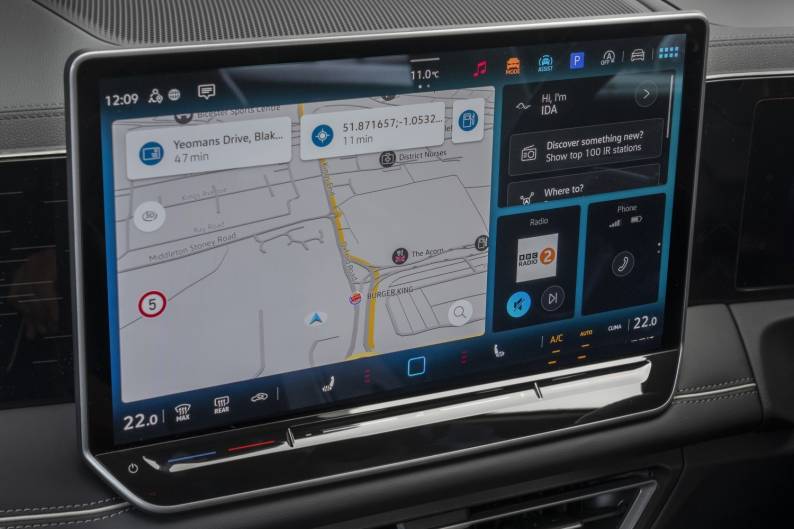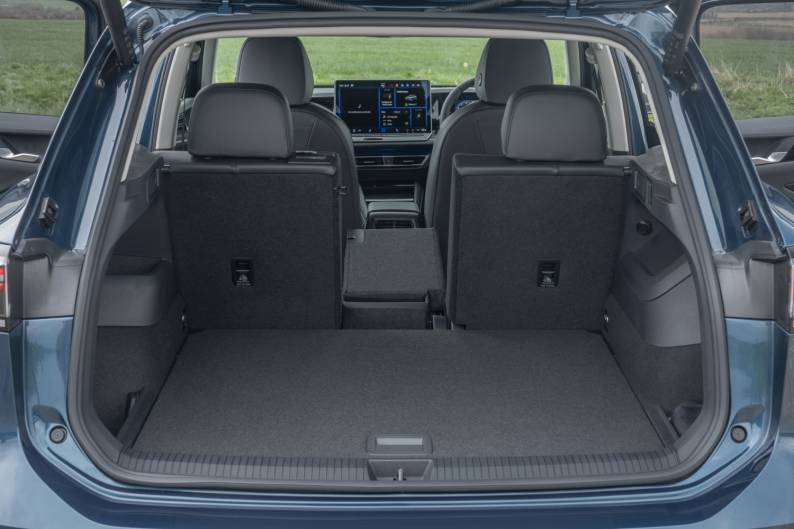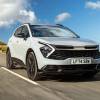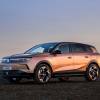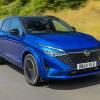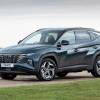
RAC sale – up to 33% off*
• Roadside cover from £5.29 a month†
• We get to most breakdowns in 60 mins or less
• Our patrols fix 4/5 breakdowns on the spot

The Volkswagen Tiguan enters its third generation as a grown up family SUV with premium aspirations. Is it any good? Lawrence Allan finds out.
Things you'll like
- Roomy and practical cabin
- Composed drive
- Classy interior feel
Things to consider
- There are more affordable rivals
- Some key kit is optional
- Ride is a little on the firm side
What is the Volkswagen Tiguan?
Many cite the Nissan Qashqai as the defining family SUV icon. And they’re probably right. But the Volkswagen Tiguan deserves an honourable mention.
While the Qashqai was first on the scene in 2007, the first-generation Tiguan arrived only a year later to offer tough competition. Just like its Japanese (but British-built) challenger, the Tiguan took hatchback underpinnings – the Golf, in this case – and transformed them into something more practical and more desirable.
And the rest is history: SUV-shaped cars of all sizes are now a global phenomenon. And the Tiguan? Well, with a massive 7.6 million global sales later it’s as important a car in VW’s range – some argue even more so – as the venerable Golf and Polo.
It’s amazing to think, too, that those sales figures were achieved with just two generations. And it means this new, third-gen Tiguan has some serious boots to fill. It’s larger, more high-tech and offers huge advances in hybrid propulsion. But can it live up to the legacy? Our review aims to find out.
Verdict: is the Volkswagen Tiguan a good car?
The latest Tiguan is a solid, capable and well-equipped all-round family SUV. Sure, it doesn’t move the game on leaps and bounds over the old model, or the competition. But with a broad enough range of talents, a decent driving experience and – most importantly – improved practicality, it’ll prove a popular car for growing families.
Pricing, specs & rivals
The Volkswagen Tiguan is more expensive in list price terms than the Nissan Qashqai or Kia Sportage, for example, but it’s established itself as a ‘semi-premium’ model.
The entry-level Tiguan – so basic it doesn’t even have a trim level name – is only offered with the lowest-powered 1.5 TSI petrol engine and is priced from £35,105 at the time of writing (January 2025). It gets kit such as 17-inch alloys, the full suite of infotainment, a rear-view camera, all-round parking sensors and single-zone climate control.
We’d recommend at stepping up to Life trim as it’s a modest walk up, starting from £36,950. That gives you access to the more powerful petrol (a worthwhile £800 upgrade) or the 2.0-litre diesel (£1200 on top of that). It’s also the cheapest trim you can get with the eHybrid PHEV variant.
Life trim comes with kit such as 18-inch alloys, ambient lighting, electric lumbar support in the front seats, voice control, wireless phone charging, adaptive cruise control, three-zone climate control and electric folding mirrors.
Match trim (from £37,125) looks decent value, adding kit such as an electric tailgate, keyless entry, upgraded dynamic LED lights with a full-width front light strip and laminated glass. Elegance trim is the first to break the £40k barrier with 19-inch alloys, upgraded ambient lighting, heated front seats with a massaging function and a 360-degree camera system.
Popular R-Line (from £40,725) focuses on styling upgrades such as 20-inch wheels, posher exterior detailing and sports seats with upgraded upholstery, while top-spec Black Edition (from £46,605) throws in the kitchen sink and adds black exterior detailing.
Rivals
The Tiguan has been around almost as long as the Nissan Qashqai, but these days the latest SUV has a vast array of alternatives to compete with. If badge appeal isn’t important the closest of these are the Qashqai along with the Ford Kuga, Honda CR-V, Hyundai Tucson, Kia Sportage, Peugeot 3008, Renault Austral, Toyota RAV4 and Vauxhall Grandland.
If you’d like something with a more premium air and don’t mind sacrificing a bit of space, check out the Audi Q3, BMW X1, Mercedes-Benz GLA and Volvo XC40.
Volkswagen Tiguan: Interior comfort, quality & technology
The Tiguan’s interior is very similar to that of the Passat, meaning a smart overall design and good – if not outstanding – quality. There’s plenty of soft-touch materials, gloss black trim and silver elements, while higher spec models have patterned ambient lighting on the dash and doors – a neat touch.
VW isn’t leaps and bounds above its mainstream competitors for interior quality any more, but the Tiguan is among the best without troubling premium brand alternatives.
It also offers a comfortable cabin environment, with supportive seats and plenty of adjustment in the driving position. Electric lumbar adjustment is also standard across the range, too, and opting for Elegance trim includes adjustable thigh support and massaging seats.
The Tiguan also resists the design trend for pinched side and rear windows, with a large glass area giving a good all-round view out for the driver. All-round parking sensors and a rear-view camera are standard across the range, too.
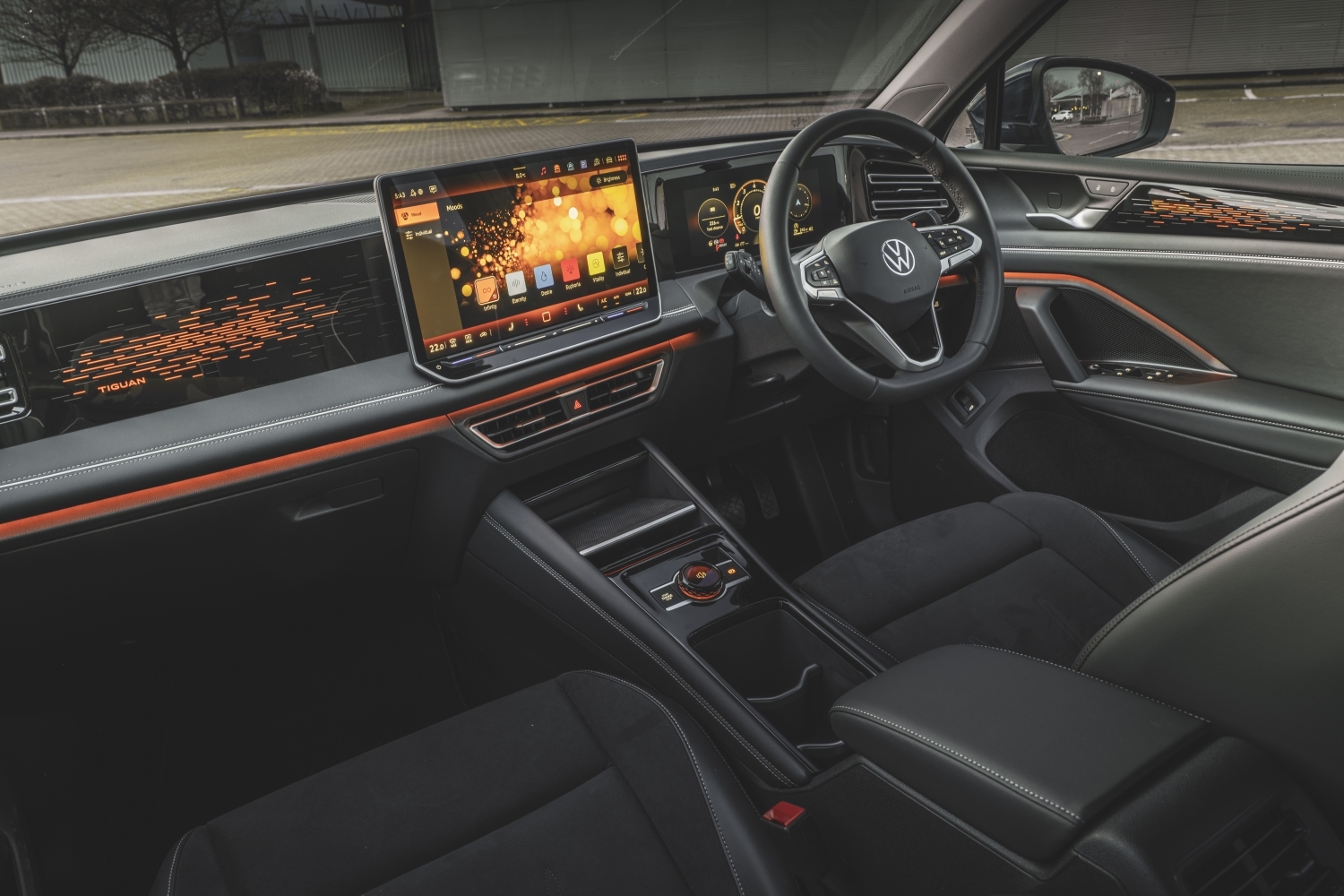
Infotainment, sat-nav, stereo and connectivity
As standard every Tiguan comes with a freestanding 12.9-inch infotainment touchscreen running the brand’s latest software. Life trim and above furnishes that with wireless phone charging, sat-nav and a natural speech voice control system.
If, for some reason, such a screen simply isn’t large enough for you, you’ll want to tick the ‘Infotainment Package Plus’ option box. That upgrades the screen to a gargantuan 15 inches, as well as adding a useful head-up display to the equipment roster.
Both screens have the same software and graphics, though, so it’s really just a size upgrade for added usability on the move. It’s a big improvement over the earliest version of VW’s new-age infotainment, with quicker responses and more intuitive menu layouts. Customisable shortcuts also add a user-friendly touch.
Familiar criticisms remain, however. Whereas other VW Group brands (such as Audi and Skoda) maintain physical climate control switches, the Tiguan continues with fiddlier touch-sensitive controls and screen menus. The haptic temperature buttons below the screen are now backlit, unlike earlier efforts, but still aren’t as easy to use as the best systems.
At least you get proper steering wheel buttons, plus a new rotary dial with an OLED display on the centre console. This can be used for volume adjustment and drive mode or ambient lighting selection, and it’s a doddle to operate – in fact, it’s a shame it’s not utilised for other infotainment functions.
Along with the usual wireless Android Auto and Apple CarPlay, you get front and rear USB-C connectors, while wireless phone charging is standard on Life trim and above. The base eight-speaker audio system offers decent sound quality, but there’s an optional 700-watt, 10-speaker Harman Kardon upgrade if ‘decent’ isn’t enough for you.
How practical is the Volkswagen Tiguan?
The latest Tiguan has grown in external size to the point that you really can’t consider it a Golf on stilts. It’s nearly 26cm longer than the latest Golf, for example, and nearly 18cm taller.
While that might mean a bit more faff when it comes to parking, it pays dividends when it comes to interior space – there’s quite a lot of it. Adults have expansive head and legroom up front and comfortable seats to stretch out in, while a wider cabin than a conventional hatch means plenty of elbow room, too.
That’s the case with most of this car’s rivals, but the VW’s rear seat space is among the best of all family SUV alternative. Legroom might not be quite as limo-like as, say, a Passat, but it’s plenty for six-footers to get comfortable, while there’s a huge amount of space to slide your feet under the front seats. Headroom shouldn’t be an issue even for the exceptionally tall, either – even with the panoramic glass roof fitted.
The only minor black mark is the lack of a fully flat floor in the rear of the Tiguan. It’s the only reason a third adult in the middle seat might whinge about space, because there’s enough width and kneeroom for three across the back.
Nice touches like separate climate controls for rear passengers (on all Tiguans except the most basic level), outer seats that slide forward and back to juggle passenger and boot space, and reclining backrests, further boost comfort. As you’d expect for this class there are also three ISOFIX points that are easily accessible.
Storage and boot space
The Tiguan is almost as good at storing family detritus as it is at storing your actual family. As well as a large glovebox, a sunglasses pocket and generous door bins (the latter lined with felt to stop items rattling) there’s a flexible storage area in the centre console.
Lift up the centre armrest and you’ll find a deep space with moveable dividers, while the cupholders in front of those can also be lifted out to reveal further space. Under the dash you’ll also find a space for a pair of phones with a lid to keep them out of sight.
In the rear you’ll also find chunky door bins that can take a large bottle, pockets in the front seatbacks (with smaller phone pockets above) and cupholders in the centre armrest.
Another boon is the 40/20/40 split-folding rear seatbacks, allowing you to through-load long items while still carrying two rear passengers. Pull out handles in the boot make dropping each seatback easy. But that’s nothing compared to the Tiguan’s boot space.
At 652 litres in capacity (for most models) it’s larger than pretty much all of its rivals, and not far off the Passat estate. It’s well shaped, with a wide opening that isn’t too high off the ground. All but the entry-level Tiguan trim come with an adjustable boot floor to remove the load lip and leave loads of underfloor storage, Deep side pockets also stop smaller items rolling around.
Unfortunately, the big battery of eHybrid models takes up a chunk of space under the boot floor, dropping the capacity to 490 litres. That’s lower than the Sportage and Kuga PHEVs, but then those cars have much smaller batteries.
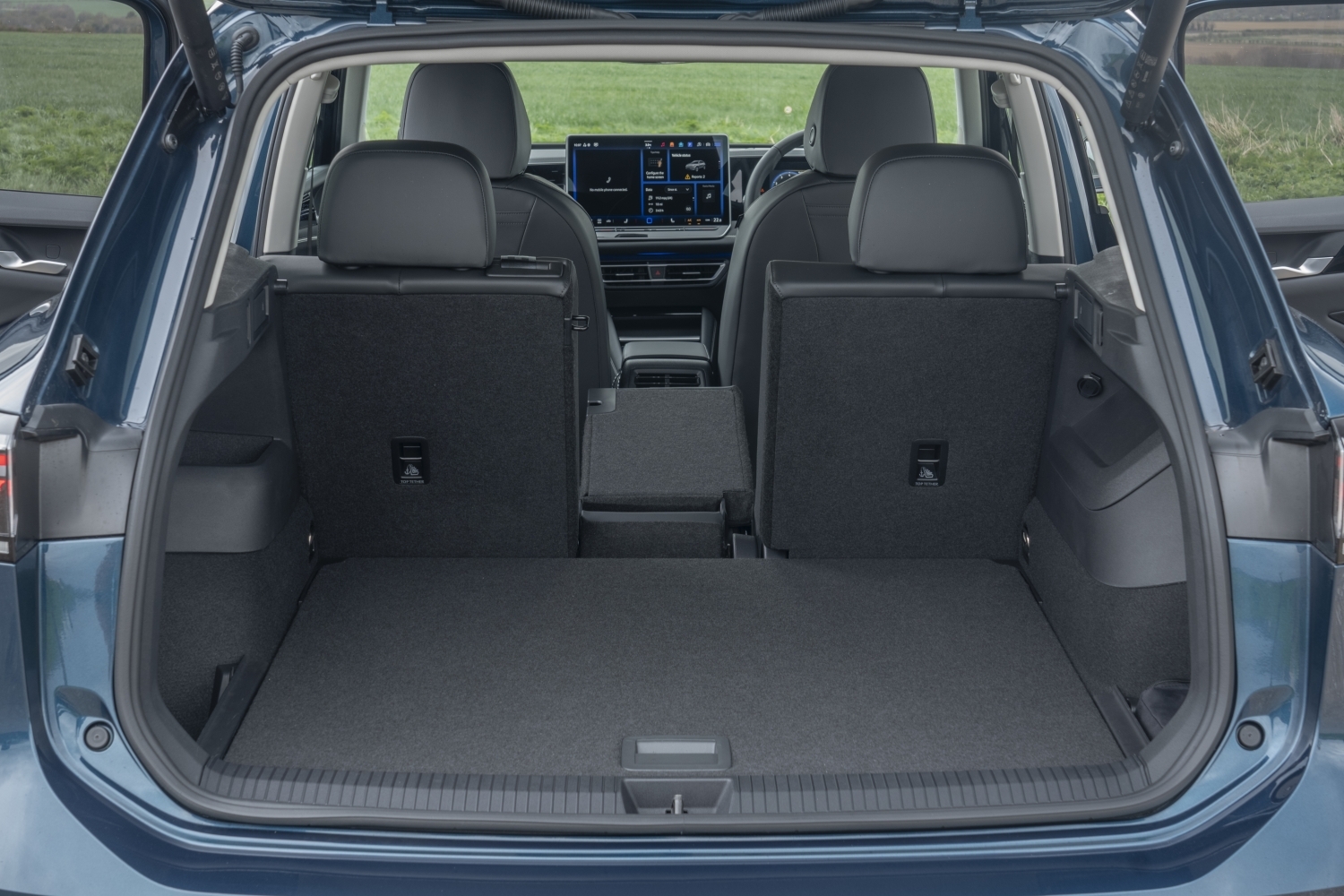
Performance & drive: What is the Volkswagen Tiguan like on the road?
Most private Tiguan buyers are expected to plump for the venerable 1.5-litre four-cylinder turbo petrol engine that’s seen service across the VW group for years now.
It’s a decent unit made more efficient in the latest model, now dubbed ‘eTSI’. That’s because it adopts mild hybrid assistance, allowing it to activate the start-stop while still moving, coast when you lift off the throttle and provide a small electric ‘boost’ under acceleration.
Both 1.5-litre engines have it in the Tiguan, but it can’t do much about the 130hp entry-level unit’s modest performance. It’ll be fine if you’re pottering about town but will feel gutless on the open road – particularly if fully-loaded. The 1.5 TSI can get quite vocal when revved, too.
The 150hp version feels a good deal stronger, with ample performance for everyday driving. Its well-paired with the seven-speed automatic gearbox that’s standard across the Tiguan range – but can be hesitant when moving off-the-line.
VW is also bucking the trend by still offering a diesel option in 2024 (many rivals don’t). We’ve yet to try the 2.0 TDI unit in the latest Tiguan, but traditionally it’s been punchy, flexible and efficient – if a bit noisy at times.
It’s tough to recommend the 2.0 TSI petrol unless you’re dead set on having hot hatch levels of performance. It doesn’t really suit the relaxed dynamics of the Tiguan, however, and it won’t be cheap to run.
The two eHybrid plug-in hybrid models make much more sense. With an impressive all-electric range of up to 77 miles, the 204hp version offers ample performance along with remarkable efficiency potential, although their up-front cost means private buyers might struggle to justify going for them.
Power, 0-62mph times
- Tiguan 1.5 eTSI 130: 130hp/ 10.6 secs
- Tiguan 1.5 eTSI 150: 150hp/ 9.1 secs
- Tiguan 2.0 TDI 150: 150hp/ 9.4 secs
- Tiguan 2.0 TSI 265: 265hp/ 5.9 secs
- Tiguan eHybrid 204: 204hp/ 8.2 secs
- Tiguan eHybrid 272: 272hp/ 7.2 secs
Ride and handling
In base, standard suspension form, the Tiguan aims for all-round competence rather than standing out in any area – put simply, it does what it needs to do without much surprise or delight. The ride, for example, is composed most of the time, but is a little more firmly set up than some alternatives.
A Hyundai Tucson or Volvo XC40 is a bit less busy over less-than-perfect tarmac, although the VW is less jiggly over bumps than a BMW X1. Even at motorway speeds the Tiguan isn’t nearly as smooth and cossetting as the more softly-sprung Passat, for example, but it’s not bad overall.
Things improve with the DCC Pro adaptive suspension – standard on R-Line or optional with the Dynamic Driving Package. This allows you to chose from a full 15 settings ranging from the most comfortable to the sportiest, giving the Tiguan a more serene ride than usual in the former settings.
All Tiguans feel well-controlled on the handling front, with accurate steering, no excessive body lean in bends and plenty of grip. Again, the DCC Pro-equipped models allow even flatter cornering in the Sport suspension settings, but even with this fitted there’s very little fun to be had. An X1 is far more engaging, but we question whether that’s a priority in a family-focused SUV such as this.
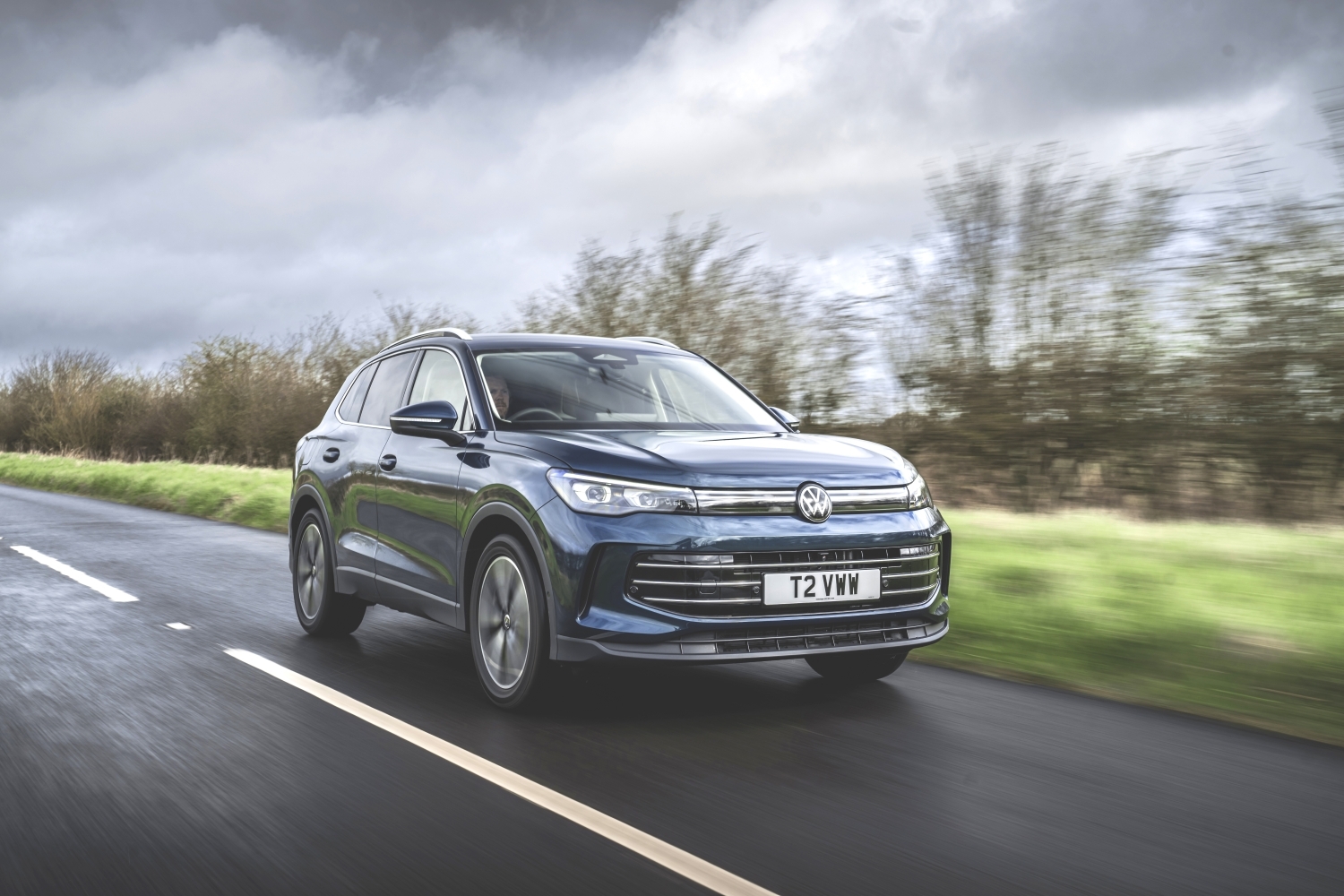
Noise and refinement
The Tiguan is generally a refined cruising companion with low levels of wind noise and (on models with smaller wheel options) decently isolated road noise. Opt for an R-Line or Black Edition model on bigger wheels and you’ll gain a bit more tyre roar, though, while models with the DCC Pro adaptive suspension fitted are better at isolating bumps from the cabin.
Engine noise varies depending on which model you go for. The 1.5 TSI engines can need working to get the Tiguan up to speed, while the 2.0-litre models are more effortless. The plug-in hybrids are the quietest, however, particularly when using their extensive electric range.
Euro NCAP: is the Volkswagen Tiguan a safe car?
It’s vital that cars such as the Volkswagen Tiguan – pretty much the default choice now for buyers with children – are considered safe. So it’s good to see the latest model achieving the maximum five-star safety rating in testing by Euro NCAP.
The Tiguan’s scores make it a solid all-rounder, with the 88% child occupant protection rating a particularly highlight, although there are cars such as the Renault Austral with even higher adult protection scores.
It also scored well for safety assistance tech, partly because the autonomous emergency braking system effectively recognised pedestrians and other cars. Blind spot monitoring, lane keeping assistance, traffic sign recognition and a driver fatigue monitor are standard across the range, while front and rear cross-traffic alert is also included even on base versions.
Also thrown in is an exit warning system, oncoming vehicle braking when turning and swerve support, and a rear-view camera with all-round parking sensors to help avoid parking dings. You’ll need Life trim and above for adaptive cruise control, though.
Fuel economy and running costs
It’s expected that most private Tiguan buyers will plump for either version of the 1.5 eTSI petrol engine, which is among the best in class for efficiency thanks to mild hybrid tech. The lower-powered 130hp version manages 46.3mpg, whereas the 150hp unit manage 45.6mpg – we’d recommend opting for the latter given the insignificant difference.
Those expecting to do lots of motorway miles might instead prefer an old-school diesel engine, and the 150hp 2.0 TDI in the Tiguan manages a decent 52.3mpg combined. It’s easier to recommend than the 2.0 TSI with its wince-inducing 33.2mpg official figure.
Thanks to its impressive electric range the official figures for the plug-in Tiguan eHybrid look mind-boggling: 706mpg for the 204hp version and 565mpg for the 272hp version. Of course, you won’t get anything near that if you spend more time running the petrol engine than in electric mode, but if you’re disciplined with charging and your regular drives fit within the car’s EV range you could well achieve that.
The bulk of the tax savings for the Tiguan eHybrid are for business users, with CO2 emissions as low as 9g/km. However, it makes less sense for private buyers, particularly as the higher list price means you’ll also be stuck paying £590 a year for five years in tax due to the ‘Expensive Car Supplement’.
Volkswagen Tiguan eHybrid: electric range and charging
The Tiguan eHybrid is at the cutting-edge of what plug-in hybrids (PHEVs) can achieve. The range is significantly more than similar models from just a couple of years ago – up to 77 miles of range for the eHybrid 204 and 72 miles for the eHybrid 272.
That’s doen to an impressive 25.7kWh battery (20kWh usable) that’s bigger than the EV battery in the base Fiat 500 Electric. It results in a far more impressive range than the Kia Sportage and Ford Kuga PHEVs – both of which manage about 42 miles officially.
To charge the Tiguan eHybrid you also get access to DC rapid charging – unlike older plug-ins that can only use slower AC charging. It’ll take in charge at up to 50kW, allowing a 26-minute 10-80% charge time. That’ll be more like four hours if you use a home wallbox.
The Tiguan eHybrid also gets a warranty that guarantees the battery will stay above 70% capacity for five years or 100,000 miles.
How much does the Volkswagen Tiguan cost to insure?
The Tiguan shouldn’t cost significantly more to insure than any of its key rivals. Sitting in insurance group 18, the entry-level 1.5 eTSI 130 model will be the cheapest to insure, with the top-spec 2.0 TSI 204 Black Edition sitting in group 30. Those groups roughly mirror the ranges of cars like the Hyundai Tucson and Peugeot 3008, for example.
Volkswagen Tiguan FAQs
Is the Volkswagen Tiguan bigger than a Golf?
Yes, the Tiguan is substantially bigger than the VW Golf in every dimension. At 4539mm long, 1660mm tall and 1842mm wide the 2024 Tiguan is 257mm longer, 53mm wider and 177mm taller than the latest Golf, meaning more space for passengers and luggage.
What is a VW Tiguan comparable to?
The Tiguan has numerous rivals that are a similar size and price including the Hyundai Tucson, Kia Sportage, Vauxhall Grandland and Honda CR-V.
How much does the 2024 Volkswagen Tiguan cost?
As of early 2025 prices for the Volkswagen Tiguan start at £35,105 for the entry-level model, with top-spec Black Edition starting at £46,605. These prices will rise if you opt for more powerful engines or hybrid models.


